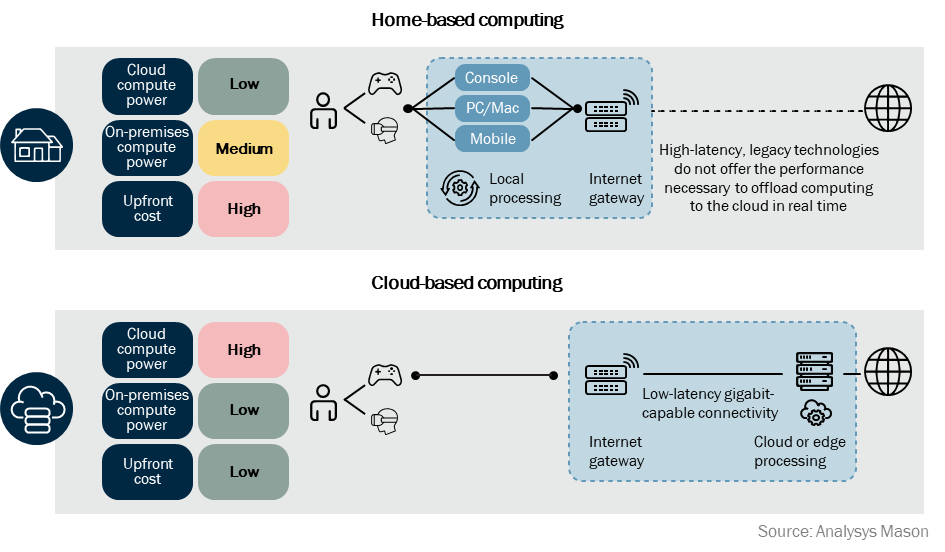Cloud XR: overcoming on-headset computing challenges with low-latency ultra-fast connectivity
Extended reality (XR) is an emerging term that encompasses all forms of immersive experiences such as virtual reality (VR) and augmented reality (AR). Real-time XR applications require significant computing power; for rendering graphics and interpreting the user’s environment.
The combination of these requirements leads to the need for extensive compute power to render these realistic virtual worlds. The current paradigm is that computation and rendering happen in the same place as the use cases. As a result, two approaches to delivering this compute power are used.
- A standalone approach uses the headset’s onboard computing power to perform all calculations. Examples of this include Apple’s Vision Pro, Meta’s Quest and Microsoft’s B2B-focused Hololens.
- A tethered approach uses high-end computers or consoles connected to the headset via wired or local wireless networks (for example, Wi-Fi). Examples of this include Sony’s PSVR2 headset and Steam’s Index VR.
Both approaches have constraints that may limit the attractiveness of these future platforms. Onboard processing power is limited, compared to standalone computers/consoles, leading to graphics that are generally subpar compared to state-of-the-art virtual environments. This can limit attractiveness of the applications, especially for B2C users. In addition, headsets with onboard processing tend to be bulkier, to accommodate the larger battery and cooling.
Conversely, when using external computing resources, headsets generally require a physical connection to a computer or console (for power and data), which can be clunky when using immersive applications. Local area connectivity is also possible, assuming the Wi-Fi network offers sufficient performance, which is far from guaranteed today, especially in interference-prone dense urban areas and considering that the network performance must be sustained at all times.
Real-time cloud computing, such as cloud XR, could drive the widespread adoption of VR/AR
One solution to offset some of these problems is cloud XR. In this model, computing and rendering are offloaded to the cloud, and the headset is merely a head-mounted screen with an array of sensors and connectivity. This model could combine the best of the tethered and standalone approaches by offering:
- high-fidelity calculation for graphics, physics, data processing and AI agents etc., thanks to the greater processing power offered by cloud computing
- a lighter device in a more compact form factor, due to lower on-device processing needs, which would improve the device battery life and mobility of users, not only within local environments but potentially outdoors and basically anywhere that has high-throughput, low-latency and reliable wireless network coverage.
It should be noted that the above features are expected to progressively allow for more discreet form factors and easy-to-wear headsets (for example, they could be similar to a pair of glasses), which are arguably more likely to succeed than the current bulky form factors. In addition, the lack of upfront costs for acquiring the computing equipment, combined with the probable decline of headset prices with economies of scale (especially screens and sensors), has the potential to democratise XR applications.
Cloud XR (Figure 1) requires high-quality connectivity to enable the shift of computing power from home-based devices to the cloud, which may represent a major barrier to its widespread adoption.
Figure 1: Comparison of home- and cloud-based XR applications

Cloud XR has clear parallels with cloud gaming, with the caveat that the network requirements are similar, but cloud XR applications need even higher bandwidth and lower latency. As reported in the latest Analysys Mason consumer survey, we expect cloud gaming to soon move beyond early adoption and into the mainstream, fostered by fixed access network technologies, such as FTTH and modern Wi-Fi (6 and 6E), that are becoming more widespread. These fixed networks already support implementations of cloud XR, based on VR only, as demonstrated by the first commercially available solutions, such as Shadow VR or Plutosphere. As these in-home applications progressively develop, they will in turn foster a market for more advanced XR applications, both B2C and B2B. These applications will also be able to extend out of home, thanks to advanced standalone 5G networks, creating an opportunity for a variety of use cases beyond gaming.1
All in all, cloud XR could revolutionise many B2B and B2C applications. The advent of new wireless technologies that cater to both local- and wide-area networking could enable new use cases.
TMT stakeholders need to understand the complex cloud XR value chain to take advantage of the investment opportunities
Just like the case of cloud gaming discussed above, cloud XR requires a complex ecosystem of telecoms, media and technology (TMT) players to work together. Here are some of the main questions that industry stakeholders should address.
- How can application and content providers take advantage of the availability of relevant headset and cloud technologies to realise the revenue potential of these new augmented experiences, both B2B and B2C?
- Will network providers be able to capitalise upon these new experiences to increase the attractiveness of, and revenue from, their next-generation networks, for instance by bundling services and network slices?
- How can cloud infrastructure providers and investors get a view of this burgeoning ecosystem that helps them to improve their ability to prioritise their investment in terms of data-centre facilities, hardware and software?
- What do technology companies need to understand about the potentially disruptive trends that accompany cloud XR (new screen technologies, new sensors, new connectivity chips, ultra-energy efficiency…) and could produce new industry champions?
1 Standardisation bodies are already working on XR use cases; for instance, 3GPP has been actively targeting XR applications for 5G since Release 17 (March 2022), with the intention of expanding upon such applications in subsequent releases.
At Analysys Mason, we have spent the last 35 years working with clients across the TMT space tackling some of the sector’s most challenging issues, from digital infrastructure to regulation. We look forward to discussing these questions with you and hearing your thoughts on cloud XR opportunities and challenges. For more details, contact Sylvain Loizeau and Andrea Betteto.
Article (PDF)
DownloadAuthors

Sylvain Loizeau
Principal, expert in telecoms strategy and regulation
Andrea Betteto
ConsultantRelated items
Predictions
GPUaaS revenue will quadruple in the next 5 years, powering new data-centre investment opportunities
Predictions
Regulatory policy will demand a pivot from higher speeds to network coverage and resilience
Predictions
AI adoption is surging, but <25% of portfolio companies’ AI tools will fully succeed in 2026

